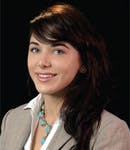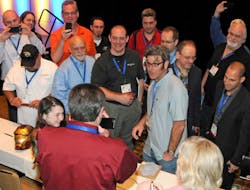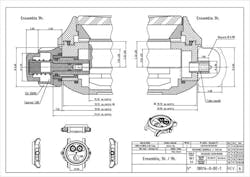At SCI-Arc, one exotic glue-draping application even builds forms in the air while showcasing how the latest is robot controls can change the arm's moves and adjust for how dynamic 3D-printing material behaves.
This is a representative installation of new eductational-level 3D printing laboratories made partly possible by groups like the Additive Manufacturing Users Group. AMUG is an organization based in Chatsworth. Calif., just north of Los Angeles, that educates users on additive manufacturing technologies. AMUG members include commercial additive manufacturing/3D printing technologies for companies such as 3D Systems, Stratasys, ExOne, Concept Laser, Renishaw and SLM Solutions. Online at www.am-ug.com. (Attend their 2014 Education & Training Conference in Tucson, April 6 to 10, 2014. Now in its 26th year, it’s open to owners and operators of all additive-manufacturing (3D printing) technologies.
But in California, Silicone Valley is still a major powerhouse of innovation in 3D printing. On the heels of the Inside 3D Printing Expo last month in San Jose, Hewlett Packard CEO Meg Whitman just announced that her San-Jose-based company will begin making 3D printers that are faster and cheaper than current offerings, hopefully in 2014.
There are synergies to tap in the area. TechShop San Jose, one of the first membership-based do-it-yourself workshops in the U.S. providing members with the use of 3D-printing and other equipment, offers numerous classes to technical and non-technical folks alike. Opened in 2006, the shop now boasts 15,000 square feet of play and build space. It's also inspired other locations around the U.S.
Commercial manufacturing takes other routes, for now. Consider one project on display at nearby at the Autodesk Inc. Gallery, San Francisco. Watchmaker Ulysse Nardin is showcasing a new watch designed in Autodesk's software and then 3D printed for rapid prototyping before final production.
Ulysse Nardin’s Sonata Silicium is a mechanical 24-hour alarm watch with a countdown display that lets the wearer set the alarm a day in advance and clearly visualize time remaining. More than 400 tiny parts work in concert. During design, exploded visualizations in the CAD software helped the designers plan the approach for assembling the moving parts. Detailed 2D drawings recorded important information and supported the assembly process. Next, the designers digitally modeled each part in 3D. Finally, the designers used the 2D and 3D drawings for rapid prototyping and then a final production run.
For connectivity, Autodesk's 3D Print Utility software connects the company's design software with myriad 3D printers, including Makerbots.
There's competition in CAD-plugin software space, though. Last month, 3D Systems purchased a company called TeamPlatform that sells cloud-based collaboration portal tools. Based in Sunnyvale, Calif., TeamPlatform represents just another tool in 3D Systems' increasingly diverse 3D-printing hardware and software offerings.
Last but not least, a company called FATHOM based in Oakland, Calif., was just ranked by Inc. magazine as the nation’s fastest-growing 3D printing and rapid-prototype production center — number 369 on the 32nd annual Inc. 500|5000 ranking of the most rapidly expanding private companies in the U.S. FATHOM is a product-development company that uses 3D printing and additive manufacturing to help customers quickly take ideas to production with model finishing, machining, molding, mold tooling, laser cutting and scanning, design services, and 3D-printer sales. To make the cut, companies needed a minimum of 918.59% in sales growth.




